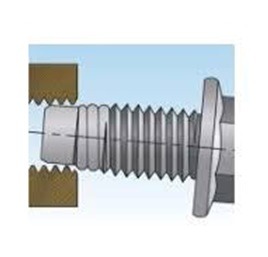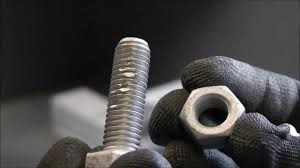Why Does a Nut Suddenly Stop Turning? It Could Be Thread Galling
You have started tightening a nut but the nut won't screw all the way – what is the problem?
Why Won't a Nut Screw All the Way?
Nut Won't Thread on Bolt (Cross Threading)
If this happens during the first few turns, it's likely you've cross-threaded the nut. This means the nut isn't aligned properly with the threads on the bolt. You'll typically notice this happening right away because the nut will go on at an angle and feel tight or uneven as you turn it.

If you suspect you've cross-threaded the nut, carefully remove it and inspect the threads on the bolt. If they look undamaged, you can try again, making sure the nut is properly aligned with the threads. Forcing a cross-threaded nut can damage the threads on both the nut and bolt, so take your time and be gentle.
Thread Galling
Thread galling is the locking and seizing up of threads during installation. It is sometimes called cold welding. It is actually a wearing of the metal, caused by friction and adhesion between the two metal surfaces of the nut and bolt.
When this occurs, the coating of the nut and bolt starts to break down and fuse together. In extreme cases galling can completely weld the nut and bolt together making it virtually impossible to take apart.

Thread galling is most common on stainless steel fasteners during tightening. Aluminium and titanium are also prone to this problem – both of these materials have high friction coefficients. Hardened metals are generally more resistant to galling.
There are steps that you can take to minimise the problem, as follows;
- Slow down the installation speed – this will reduce the friction.
- Don’t use nuts and bolts to pull joints together – the “pulling” action increases the likelihood of galling.
- Use a lubricant such as copper grease or lubricating oil.
- Avoid using damaged or dirty threads wherever possible.
- Take extra care when using nyloc nuts – go slowly.
- If a fastener starts to seize, stop immediately.
Nut Not Going on Bolt (Other Reasons)
In some cases, there might be other reasons why the nut won't go on the bolt. These could include:
- Wrong Size or Type of Nut: Make sure you're using the correct size and type of nut for the bolt. Nuts come in different sizes, thread types (coarse or fine), and materials. Using a nut that's too small won't engage the threads fully, and one that's too large simply won't fit. Similarly, a nut with a different thread type (e.g., metric vs. SAE) won't match the bolt's threads at all. Double-check the nut size and thread type markings to ensure compatibility with the bolt. By understanding these two common problems and following the preventative tips, you can keep your nuts and bolts turning smoothly for a long time.
- Debris or Dirt Caught in the Threads: Dirt, debris, or rust particles lodged in the threads can prevent the nut from fully engaging. Clean the threads of both the nut and bolt thoroughly with a wire brush or compressed air before assembly. You can also use a cleaning solvent to remove any stubborn grime.
- Damaged Threads: Damaged threads on either the nut or bolt can prevent them from engaging properly. Take a moment to inspect the threads on both the nut and bolt for any damage or debris before attempting assembly.
By taking these preventative measures, you can ensure a strong and secure connection whenever you're working with nuts and bolts.

